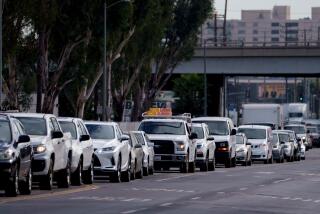Proximity to freeways increases autism risk, study finds
Children born to mothers who live close to freeways have twice the risk of autism, researchers reported Thursday. The study, its authors say, adds to evidence suggesting that certain environmental exposures could play a role in causing the disorder in some children.
“This study isn’t saying exposure to air pollution or exposure to traffic causes autism,” said Heather Volk, lead author of the paper and a researcher at the Saban Research Institute of Children’s Hospital Los Angeles. “But it could be one of the factors that are contributing to its increase.”
Reported cases of autism cases increased by 57% between 2002 and 2006, according to the Centers for Disease Control and Prevention, although professionals still debate whether rates have actually risen or a greater proportion of autistic children is being diagnosed. An estimated 1 in 110 children is diagnosed with autism today. There is no cure, although research has shown that various therapies can mitigate some symptoms, especially if begun early in life.
In the current study, published online in the journal Environmental Health Perspectives, researchers looked at 304 children with autism and, for comparison, 259 children who were developing normally. The children, between the ages of 24 months and 60 months at the start of the study, lived in communities around Los Angeles, San Francisco and Sacramento.
Each family was evaluated in person, and all of the children received developmental assessments. Researchers collected data on where each child’s mother lived during pregnancy and at the time of birth, and the proximity of the homes to a major road or freeway.
Children living about 1,000 feet from a freeway at birth — about 10% of the sample — had a two-fold increase in autism risk. The link held up even after researchers controlled for other factors that may influence development, such as ethnicity, parental education, maternal age and exposure to tobacco smoke.
The study did not find a link between autism development and proximity to a major road, as opposed to a freeway. That may be due to the type and quantity of chemicals dispersed on freeways compared with major roads, Volk said. In Los Angeles, some freeways carry more than 300,000 vehicles daily.
Gayle Windham, chief of the epidemiology surveillance unit with the California Department of Health Services Environmental Investigations Branch, said the study did not directly implicate air pollution as a risk factor for autism because it did not have a way of measuring how much pollution the mothers were exposed to during pregnancy.
“They are using a proxy measure for air pollution, which is distance to a freeway,” she said. “But you still don’t know how much time the women spent at home or working or commuting.” Windham was not involved in the study.
Windham was the lead author of a 2006 study, also published in Environmental Health Perspectives, that found that children with autism were about 50% more likely to have a birth residence in an area with hazardous air pollutants. The study was based on air pollution data from the Environmental Protection Agency that was matched to birth records in the San Francisco Bay Area.
Research like this suggests environmental factors need more attention, said Clara Lajonchere, vice president of clinical programs for the advocacy group Autism Speaks. Lajonchere was not involved in the study.
“The implication could be very far reaching in terms of prevention and public health concerns,” Lajonchere said. “I think it’s pretty well established that genes play a huge role in autism. But there is something going on beyond genetics.”
Chronic exposure to air pollution during pregnancy is thought to have physical effects on the fetus. High levels of carbon monoxide, nitrogen dioxide and particulate matter have been linked to a higher risk of preterm birth and low birth weight. Chemicals such as ozone, sulfur dioxide and polycyclic aromatic hydrocarbons, or PAHs, have also been identified as harmful to a developing fetus.
“We know there are some chemicals in air pollution coming from diesel exhaust that might be a good forerunner to look at,” Volk said. “But right now we really don’t know what it is about air pollution that is associated with autism.”
Families residing close to freeways may have to wait for more research before scientists can issue advice or recommendations on what to do about this potential risk, Volk said. For one thing, this study requires replication, she said. In addition, future studies will attempt to identify the level of exposure to particular pollutants.






